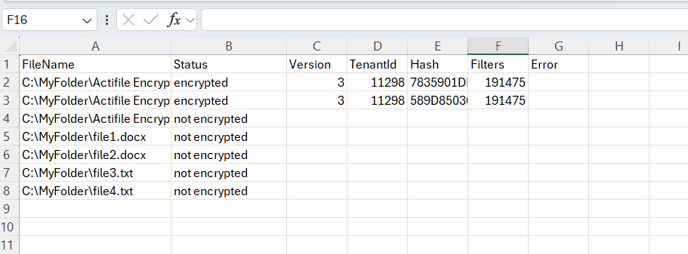AFIsEncrypted is a diagnostic utility that helps you check whether files on your machine have been encrypted by Actifile. This article outlines how to use the tool to get detailed encryption status for files and folders.
When to Use AFIsEncrypted
Use this tool when you need to:
- Confirm whether a file is encrypted by Actifile.
- Identify which tenant and classifier encrypted a file.
- Ensure no files are left encrypted before migrating data or uninstalling Actifile.
- Troubleshoot other decryption issues.
How to Run AFIsEncrypted
Step 1. Download and unzip the archive with the tool: AFIsEncrypted
You’ll find two files inside the folder:
AFIsEncrypted.exeEntities.dll
.png?width=688&height=197&name=image%20(1).png)
Step 2. Open the command line: press the Windows key, type cmd, then press Enter.
Step 3. Navigate to the AFIsEncrypted folder using
cd YOUR_PATH
Example:
cd C:\Actifile\AFIsEncryptedNote: If Actifile is running and file upload blocking is active, the tool might not be able to analyze certain files. Open Task Manager and stop Actifile processes before proceeding.
Step 4. Run the appropriate command (see Available Parameters & Examples below).
Output Format
Each result includes the following (in this order):
- FileName: File path and name
- Status: Whether the file is encrypted
If the file is encrypted:
- Version: Actifile encryptor version
- TenantId: Tenant ID used for encryption. You can find it on the Tenants page of the Partner Portal:

- Hash: File hash
- Filters: Classifier ID (internal use for support)
- Error: Any error messages returned
Available Parameters & Examples
See all supported commands
AFIsEncrypted.exeExample:
-Apr-03-2025-03-30-09-2164-PM.png?width=523&height=159&name=unnamed%20(1)-Apr-03-2025-03-30-09-2164-PM.png)
Check a Single File
AFIsEncrypted “YOUR_FOLDER_PATH\YOUR_FILE_NAME\”Example:
AFIsEncrypted "C:\Actifile Encryption Test\Finland SSN.txt”-Apr-03-2025-03-31-15-6927-PM.png?width=688&height=46&name=unnamed%20(2)-Apr-03-2025-03-31-15-6927-PM.png)
Check All Files in a Folder
AFIsEncrypted “YOUR_FOLDER_PATH\*.*\”Example:
AFIsEncrypted "C:\Actifile Encryption Test\*.*\"-3.png?width=688&height=70&name=unnamed%20(3)-3.png)
Check Files in a Folder and All Subfolders
AFIsEncrypted "YOUR_PATH\*.*" /r Example:
AFIsEncrypted "C:\MyFolder\*.*" /r-2.png?width=688&height=110&name=unnamed%20(4)-2.png)
Filter by File Extension
AFisEncrypted YOUR_PATH\*.YOUR_FILE_EXTENSIONExample:
AFisEncrypted “C:\Actifile Encryption Test\*.docx”-2.png?width=688&height=46&name=unnamed%20(5)-2.png)
Highlight Files by Hash
Use this command to scan all files in a folder and flag any that match a specific hash. If a file’s hash matches the one you provide, the tool will add a message: Input hash detected.
AFIsEncrypted "YOUR_PATH\*.*" /Hash=YOUR_HASHExample:
AFIsEncrypted "C:\MyFolder\Actifile Encryption Test\*.*" /Hash=589D85030EAAF34C063A0E4AF90EF120FD4D4686-1.png?width=688&height=98&name=unnamed%20(6)-1.png)
Combine Parameters
You can combine filters like file type, recursion, and hash detection.
AFIsEncrypted "C:\MyFolder\*txt" /r /Hash=589D85030EAAF34C063A0E4AF90EF120FD4D4686This command will:
- Search all
.txtfiles in the folder and subfolders. - Flag files that match the provided hash.
.png?width=688&height=98&name=unnamed%20(7).png)
Check Command Status with %errorlevel%
After running a command, you can quickly check the result by typing:
echo %errorlevel%Here’s what the values mean:
- 0: No encrypted files found
- 1: At least one encrypted file found
- 2: At least one file with the given hash found
- 3: An error occurred
.png?width=688&height=161&name=unnamed%20(8).png)
View the Output in Excel
Want to explore the results more easily? Here’s how to open them in Excel.
Append the following to the end of your command:
>> YOUR_FILE_NAME.csvExample:
AFIsEncrypted "C:\MyFolder*.*" /r >> Output.csv
This will create a file named Output.csv in the same folder where the AFIsEncrypted.exe tool is located. Double-click the file — it will automatically open in Excel.
